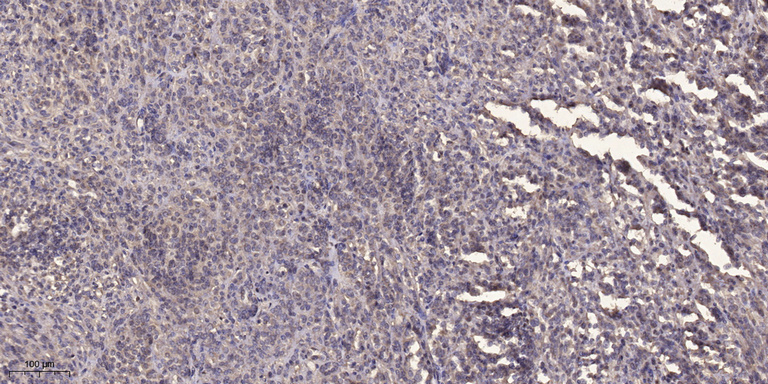Rhotekin Polyclonal Antibody
- Catalog No.:YT4090
- Applications:IHC;IF;ELISA
- Reactivity:Human;Mouse;Rat
- Target:
- Rhotekin
- Gene Name:
- RTKN
- Protein Name:
- Rhotekin
- Human Gene Id:
- 6242
- Human Swiss Prot No:
- Q9BST9
- Mouse Gene Id:
- 20166
- Mouse Swiss Prot No:
- Q8C6B2
- Rat Gene Id:
- 297383
- Rat Swiss Prot No:
- Q6V7V2
- Immunogen:
- Synthesized peptide derived from Rhotekin . at AA range: 80-160
- Specificity:
- Rhotekin Polyclonal Antibody detects endogenous levels of Rhotekin protein.
- Formulation:
- Liquid in PBS containing 50% glycerol, 0.5% BSA and 0.02% sodium azide.
- Source:
- Polyclonal, Rabbit,IgG
- Dilution:
- IHC 1:100 - 1:300. ELISA: 1:20000.. IF 1:50-200
- Purification:
- The antibody was affinity-purified from rabbit antiserum by affinity-chromatography using epitope-specific immunogen.
- Concentration:
- 1 mg/ml
- Storage Stability:
- -15°C to -25°C/1 year(Do not lower than -25°C)
- Other Name:
- RTKN;RTKN1;Rhotekin
- Molecular Weight(Da):
- 63kD
- Background:
- This gene encodes a scaffold protein that interacts with GTP-bound Rho proteins. Binding of this protein inhibits the GTPase activity of Rho proteins. This protein may interfere with the conversion of active, GTP-bound Rho to the inactive GDP-bound form by RhoGAP. Rho proteins regulate many important cellular processes, including cytokinesis, transcription, smooth muscle contraction, cell growth and transformation. Dysregulation of the Rho signal transduction pathway has been implicated in many forms of cancer. Alternative splicing results in multiple transcript variants encoding different isoforms. [provided by RefSeq, Jul 2008],
- Function:
- caution:The sequence shown here is derived from an Ensembl automatic analysis pipeline and should be considered as preliminary data.,function:Mediates Rho signaling to activate NF-kappa-B and may confer increased resistance to apoptosis to cells in gastric tumorigenesis. May play a novel role in the organization of septin structures.,similarity:Contains 1 PH domain.,similarity:Contains 1 REM (Hr1) repeat.,subunit:Interacts via its C-terminal region with the TAX1BP3 PDZ domain. This interaction facilitates Rho-mediated activation of the c-Fos serum response element (SRE). Interacts with SEPT9. Specifically binds to GTP-bound RHOA, RHOB and RHOC and inhibits their GTPase activity.,tissue specificity:Highly expressed in prostate, moderately in kidney, heart, brain, spleen, testis, placenta, small intestine, pancreas, skeletal muscle and peripheral blood leukocytes, and weakly in ovary, colo
- Subcellular Location:
- cytosol,
- Expression:
- Highly expressed in prostate, moderately in kidney, heart, brain, spleen, testis, placenta, small intestine, pancreas, skeletal muscle and peripheral blood leukocytes, and weakly in ovary, colon and thymus. Weakly expressed in all normal cell lines tested. Overexpressed in various cancer cell lines.
- June 19-2018
- WESTERN IMMUNOBLOTTING PROTOCOL
- June 19-2018
- IMMUNOHISTOCHEMISTRY-PARAFFIN PROTOCOL
- June 19-2018
- IMMUNOFLUORESCENCE PROTOCOL
- September 08-2020
- FLOW-CYTOMEYRT-PROTOCOL
- May 20-2022
- Cell-Based ELISA│解您多样本WB检测之困扰
- July 13-2018
- CELL-BASED-ELISA-PROTOCOL-FOR-ACETYL-PROTEIN
- July 13-2018
- CELL-BASED-ELISA-PROTOCOL-FOR-PHOSPHO-PROTEIN
- July 13-2018
- Antibody-FAQs
- Products Images

- Immunohistochemical analysis of paraffin-embedded human Colon cancer. 1, Antibody was diluted at 1:200(4° overnight). 2, Tris-EDTA,pH9.0 was used for antigen retrieval. 3,Secondary antibody was diluted at 1:200(room temperature, 45min).



